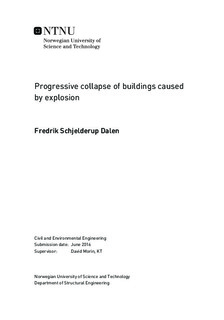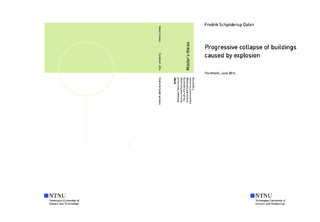| dc.contributor.advisor | Morin, David | |
| dc.contributor.author | Dalen, Fredrik Schjelderup | |
| dc.date.accessioned | 2019-09-11T08:34:57Z | |
| dc.date.available | 2019-09-11T08:34:57Z | |
| dc.date.created | 2016-06-10 | |
| dc.date.issued | 2016 | |
| dc.identifier | ntnudaim:14723 | |
| dc.identifier.uri | http://hdl.handle.net/11250/2614907 | |
| dc.description.abstract | Extreme loading may cause failure or damage to structural building members. Redistribution of forces might propagate the local failure into a complete or partial progressive collapse of the building. The prevailing method for analyzing the potential for such collapse is the alternate path method. One structural member is notionally removed to see if the forces are able to find an alternate path. Explosions might cause damage to more than one structural member and produce a structural response not included in an alternate path analysis. A literature review have been conducted to study analysis methods using both the alternate path method and methods incorporating blast loading in the collapse analysis.
It is possible to model building collapse resulting from an explosion with complex models that require large computational force. This thesis have tried to use implicit time integration instead of explicit in order to reduce computational cost, but this was not found beneficial.
Beam elements are effective, computationally effective and are easy to model. Only a small number of studies have used blast loading on beam elements in some way. A steel frame building was analyzed using beam elements with an incident wave interaction in Abaqus to model the blast load. This was compared with a model using shell elements to model the steel sections with Conwep blast loading. The blast loading on the beam elements did not produce a satisfactory response. | en |
| dc.language | eng | |
| dc.publisher | NTNU | |
| dc.subject | Bygg- og miljøteknikk, Konstruksjon | en |
| dc.title | Progressive collapse of buildings caused by explosion | en |
| dc.type | Master thesis | en |
| dc.source.pagenumber | 115 | |
| dc.contributor.department | Norges teknisk-naturvitenskapelige universitet, Fakultet for ingeniørvitenskap,Institutt for konstruksjonsteknikk | nb_NO |

